Politics
Dubai Airport begins installing AI-powered 3D scanners
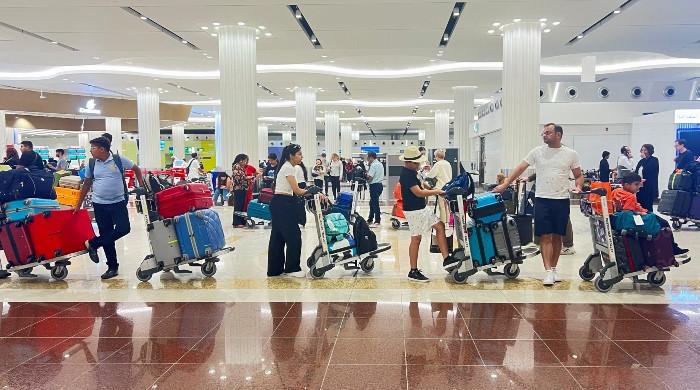
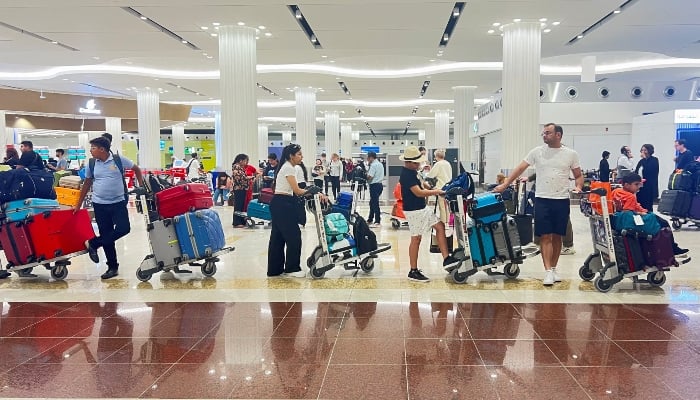
DUBAI: Dubai Airport has begun installing state-of-the-art 3D AI scanners to make security checks faster and easier for passengers.
Powered by artificial intelligence, the new scanners will screen luggage within seconds, allowing travellers to clear security checks in minimal time.
According to officials, passengers will no longer need to remove laptops, perfumes, water bottles, or other liquids during screening.
The airport administration said the project will be completed by the end of 2026, expressing confidence that the initiative will make journeys smarter and more seamless for all passengers.
The Emirati city, located between Asia, Europe and Africa, has been ranked the world’s busiest air hub for international passengers for a decade.
The facility marked its busiest first half on record with a 2.3% year-on-year growth, welcoming a record 46 million passengers in the first half of this year despite disruptions due to the Iran-Israel war.
The facility marks its busiest first half on record with a 2.3% year-on-year growth.
During the 12-day Iran-Israel war, airlines cancelled flights to many Middle East destinations as some governments closed their airspace.
In the first six months of 2025, the average monthly traffic stood at around 7.7 million passengers or 254,000 daily travellers.
In 2024, Dubai International Airport recorded its highest annual passenger traffic in history, totalling 92.3 million.
The top countries for passenger traffic to and from Dubai were India, Saudi Arabia, and the United Kingdom.
— With additional input ftom AFP
Politics
Unexploded bombs sow fear among Gazans under fragile truce


Moein al-Hattu’s home has been ripped apart, its cinder block walls blown out into the street and a dusty grey bomb hangs menacingly from a damaged pillar, its tip resting on a crushed chest of drawers.
Weighing more than a tonne, the munition was dropped during an airstrike on Gaza City during fighting between Israel and Hamas but has not exploded, yet.
“I’m living in terror and unable to remove it,” al-Hattu told AFP, as children wandering through the rubble paused to marvel at the threatening intrusion.
The grey-bearded Palestinian wants to hang tarpaulins from the shell of his bombed-out home and move back in, but has been unable to find anyone in Gaza with the skills or equipment to remove the giant bomb.
“The relevant authorities, whether the civil defence or the municipality, say they can’t remove it. Who can I go to and complain to?” he demanded.
“If it had exploded, it would have caused massive destruction and destroyed at least five to six houses.”
After two years of war, the ruined cities of Gaza, a densely packed territory home to more than two million Palestinians, are littered with military debris, including unexploded, still-deadly munitions.
In the streets of Gaza City, children play with rocket parts and the tail fins of mortar shells, oblivious to or unbothered by the danger.
According to a study by charity Handicap International, Israel has dropped around 70,000 tonnes of explosives on targets in Gaza since October 7, 2023.
Cardboard for cooking
In January this year, the United Nations Mine Action Service (UNMAS) warned that between five and 10% of these bombs did not explode — leaving their deadly payloads to be recovered by the fighters or discovered by frightened residents.
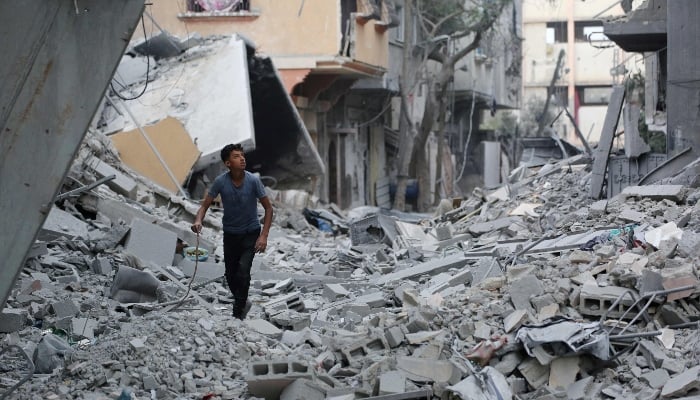
At Gaza City’s Al-Shifa Hospital, Mohammed Nour sat beside a bed holding his two injured children.
The pair watched mute and glassy-eyed, their legs bound and skin flecked with shrapnel as he explained how they had been injured.
“We were setting up our tents and the boys went to look for wood, nylon and cardboard to burn to use for cooking,” Nour told AFP.
“About ten metres away from us, we suddenly saw boys being thrown by the explosion. We didn’t think they were our children and then we found them scattered in every corner.”
Nour’s sons may yet keep their limbs but in a nearby bed, six-year-old Yahya has lost part of his right hand and is all but covered in bandages. His grandfather Tawfiq al-Sharbasi sits by him, keeping vigil and strokes his hair.
“These are children. What did they do wrong? They were playing,” he said.
Jonathan Crickx, spokesman for Unicef Palestine, told AFP it was very difficult to estimate how many children have been injured by unexploded ordnance.
“Following the recent ceasefire, we have recorded reports indicating that at least eight children were seriously injured by explosive remnants of war,” he said, adding that UN agencies are trying to raise awareness of the threat.
To date, no demining equipment has been authorised to enter the Gaza Strip by the Israeli army.
Politics
Trump Refuses to Resume Canada Trade Talks Over Ad Dispute


US President Donald Trump on Friday refused to restart trade negotiations with Canada, a week after halting talks over a dispute concerning an anti-tariff advertisement.
Speaking to journalists aboard Air Force One, Trump said he had a good personal rapport with Canadian Prime Minister Mark Carney, adding, “I really like him a lot. But what they did was wrong.”
When asked if talks would resume, the president responded with a firm “no”, despite Carney issuing an apology for the advertisement, which Trump described as false.
The dispute arose after Canada launched an anti-protectionist ad campaign, prompting Trump to suspend bilateral trade talks and impose an additional 10 percent tariff on Canadian products.
Despite the tensions, Trump reiterated that he maintains a positive relationship with Carney and noted that they had a productive discussion on the sidelines of the APEC summit in South Korea.
Earlier, at a summit in Malaysia, Carney had expressed that Canada was ready to resume trade talks with Washington.
The breakdown in negotiations marks a sudden shift in relations between the two historic allies, reflecting strains following Trump’s return to power.
Canada is the United States’ second-largest trading partner and a major supplier of steel and aluminum to US companies.
The vast majority of cross-border trade remains exempt from tariffs due to the North American free trade agreement, but sectoral levies particularly on steel, aluminum, and automobiles have hit Canada hard, forcing job losses and squeezing businesses.
Politics
Men shot by hundreds, disappeared after ‘Sudanese city falls to paramilitaries’
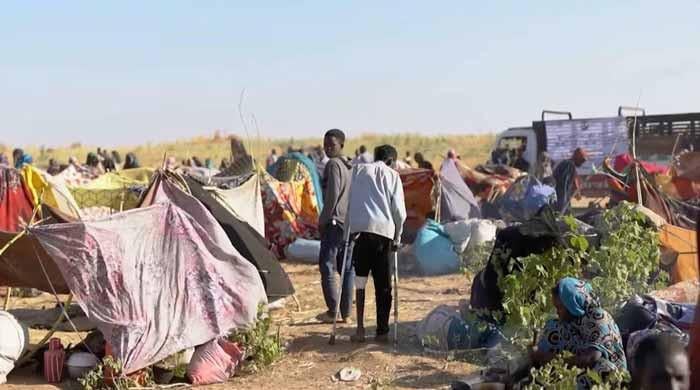
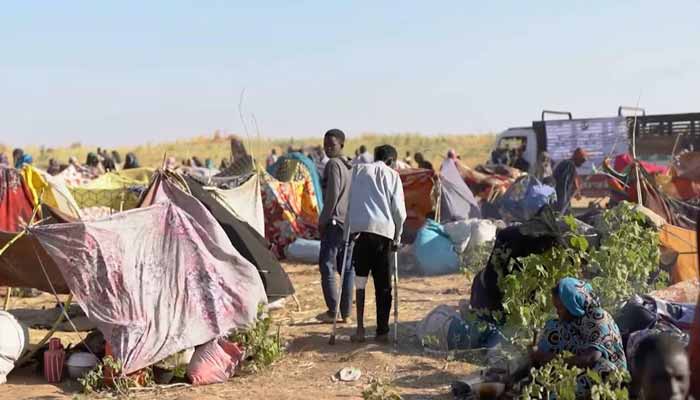
- Witness describes summary killings near reservoir.
- Rapid Support Forces deny summary executions.
- Capture of al-Fashir entrenches division of Sudan.
Fighters riding camels rounded up a couple of hundred men near the Sudanese city of al-Fashir at the weekend and brought them to a reservoir, shouting racial slurs before starting to shoot, according to a man who said he was among them.
One of the captors recognised him from his school days and let him flee, the man, Alkheir Ismail, said in a video interview conducted by a local journalist in the nearby town of Tawila in the country’s western Darfur region.
“He told them, ‘Don’t kill him,'” Ismail said. “Even after they killed everyone else — my friends and everyone else.”
He said he had been bringing food to relatives still in the city when it was captured by the Rapid Support Forces on Sunday — and, like the other detainees, was unarmed. Reuters could not immediately verify his account.
Ismail was one of four such witnesses and six aid workers interviewed by Reuters who also said people fleeing al-Fashir had been gathered in nearby villages and men separated from women and removed. In an earlier account, one of the witnesses said gunshots then rang out.
Activists and analysts have long warned of revenge killings based on ethnicity by the paramilitary Rapid Support Forces (RSF) if they seized al-Fashir — the last stronghold of the Sudanese military in Darfur.
The UN human rights office shared other accounts on Friday, estimating hundreds of civilians and unarmed fighters may have been executed. Such killings are considered war crimes.
The RSF, whose victory in al-Fashir marks a milestone in Sudan’s two-and-a-half-year civil war, has denied such abuses – saying the accounts have been manufactured by its enemies and making counter-accusations against them.
RSF says men removed for interrogation
Reuters has verified at least three videos posted on social media showing men in RSF uniforms shooting unarmed captives and a dozen more showing clusters of bodies after apparent shootings.
A high-level RSF commander called the accounts “media exaggeration” by the army and its allied fighters “to cover up for their defeat and loss of al-Fashir”.

The RSF’s leadership had ordered investigations into any violations by RSF individuals and several had been arrested, he said, adding that the RSF had helped people leave the city and called on aid organisations to assist those who remained.
He said soldiers and fighters pretending to be civilians had been taken away for interrogation. “There were no killings as has been claimed,” the commander told Reuters in response to a request for comment.
Several eyewitnesses told global medical charity Medecins Sans Frontieres (Doctors Without Borders) that a group of 500 civilians and soldiers from the Sudanese Armed Forces and allied groups tried to flee on October 26, but most were killed or captured by the RSF and its allies.
“Survivors report individuals being separated by gender, age, or perceived ethnic identity, and many who remain held for ransom, with sums ranging from 5 million to 30 million Sudanese pounds ($8,000 to $50,000),” MSF said in a statement on Friday.
The RSF’s capture of al-Fashir entrenches the geographical division of a country already reduced by the independence of South Sudan in 2011 after decades of civil war.
In a speech on Wednesday night, RSF head Mohamed Hamdan Dagalo called on his fighters to protect civilians and said violations will be prosecuted. He appeared to acknowledge reports of detentions by ordering the release of detainees.
Alex de Waal, a genocide expert and specialist on Darfur, said the reported RSF acts in al-Fashir looked “very similar to what they did in Geneina and elsewhere,” referring to another Darfur city the RSF took during the latest war’s early stages as well as the early 2000s conflict.
‘We can’t say they are alive’
Mary Brace, a protection adviser at Nonviolent Peaceforce, an NGO working in Tawila, said those arriving “are women, children, and older men generally,” adding that trucks organised by the RSF have taken some people from Garney to Tawila while others have been taken elsewhere.
The RSF on Thursday posted a video it said showed the provision of food and medical aid to people displaced in Garney. Aid workers said the force may also be trying to keep people in towns it controls to attract foreign aid.
Some 260,000 people were still in al-Fashir around the time of the attack, but only 62,000 have been counted elsewhere, and only several thousand of them in Tawila, which is controlled by a neutral force.
In another of the testimonies obtained and verified by Reuters, Tahani Hassan, a former hospital cleaner, said she fled to Tawila early on Sunday after her brother-in-law and uncle were killed by stray bullets.
On the way, she and her family were apprehended by three men in RSF uniforms who searched them, beat them and insulted them, she said.
“They hit us hard. They threw our clothes on the ground. Even I, as a woman, was searched,” she said, adding that their food and water were also spilled on the ground.
They eventually made it to Garney, where the fighters separated women and children from the men, most of whom they did not see again, including her brother and a second brother-in-law.
“We can’t say they are alive, because of how they treated us,” Hassan said. “If they don’t kill you, the hunger will kill you, the thirst will kill you.”
-

 Politics1 week ago
Politics1 week agoTrump slams ‘dirty’ Canada despite withdrawal of Reagan ad
-

 Tech1 week ago
Tech1 week agoDefect passivation strategy sets new performance benchmark for Sb₂S₃ solar cells
-

 Business1 week ago
Business1 week agoJLR shutdown after cyber hack drives slump in UK car production
-

 Tech1 week ago
Tech1 week agoTurning pollution into clean fuel with stable methane production from carbon dioxide
-

 Sports1 week ago
Sports1 week agoAlleged mob ties in NBA scandal recall La Cosa Nostra’s long shadow over sports
-

 Business1 week ago
Business1 week agoAssaults on rail network more than triple in 10 years
-

 Business1 week ago
Business1 week ago47.7% of Mutual Fund Assets Now Invested Directly, ICRA Analytics Says
-

 Sports1 week ago
Sports1 week agoNBA legend Chauncey Billups, Heat’s Terry Rozier arrested as part of FBI gambling probe






